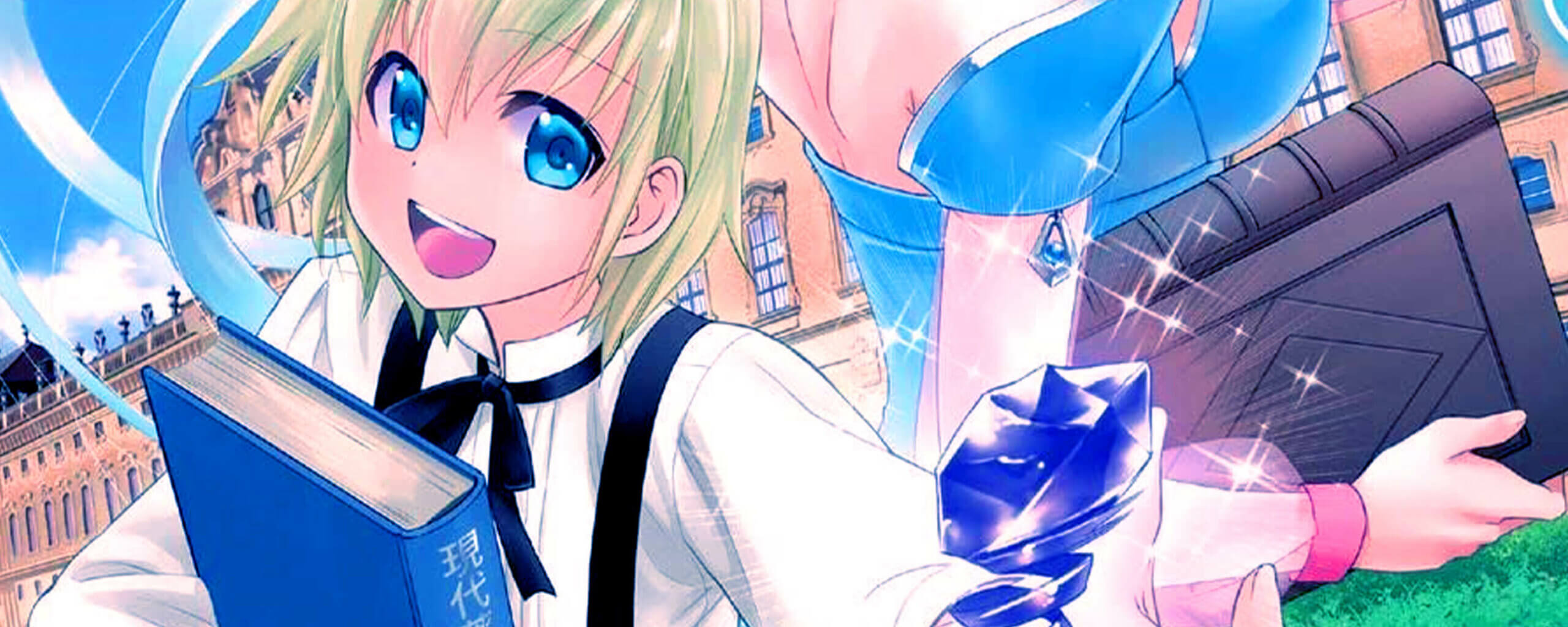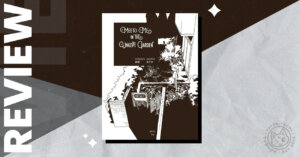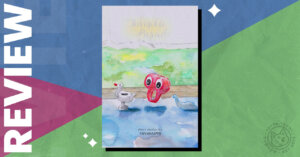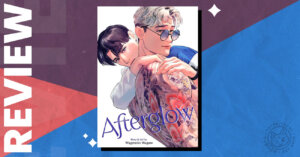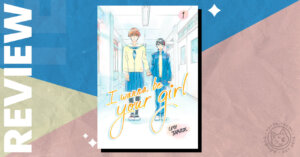Stop me if you’ve heard this one before: In modern day Japan, a guy with a difficult past dies unexpectedly. The next thing he knows, he has awoken in a fantasy land. He learns he has some special abilities far beyond those of people from this new world typically have. He uses them to basically take a mulligan on his previous life, doing in this world what he wishes he could have done in the real world.
I could be talking about anything in the long stream of isekai manga, novels, and anime that have been shoveled into the hungry maw of fandom over the past few years. For this particular review I’m talking about Sei Takano’s Parallel World Pharmacy from One Peace Books. Isekai stories get dumped on a lot, but I am not a hater. There are absolutely some great ones out there, but there’s an unavoidable repetitiveness to the premise for far too many of them.
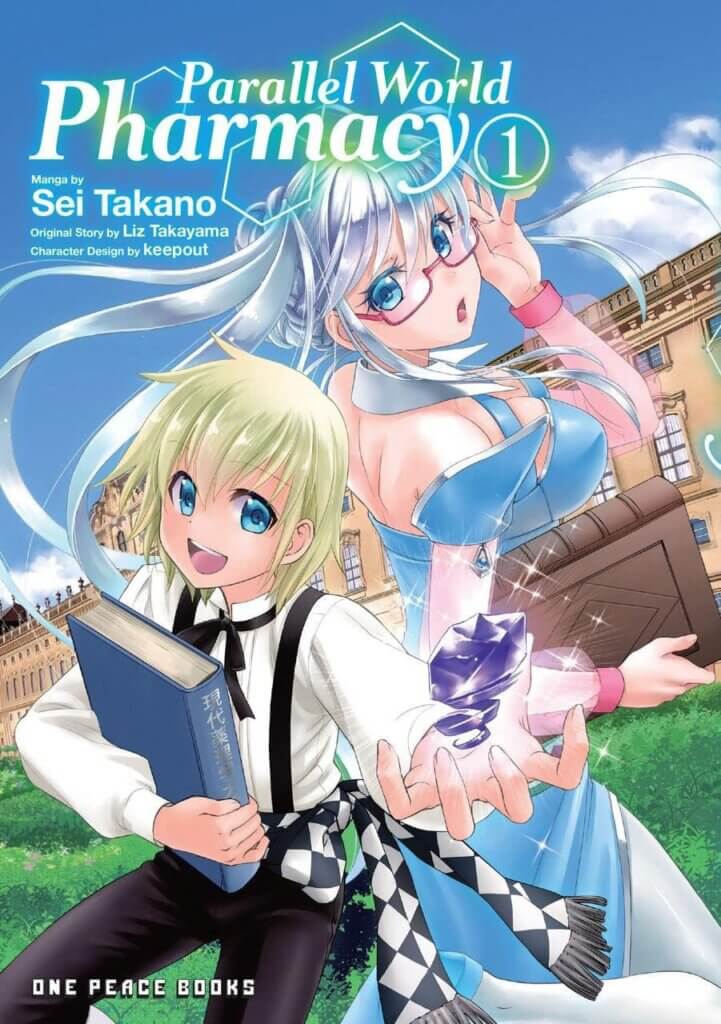
The Clear Difference
Parallel World Pharmacy manages to stand out significantly in one aspect: the particular special ability our main character gains. In Japan he was Kenji Yakutani, renowned pharmacologist and drug developer. In the other world he’s Farma de Medicis, the young son of an archduke, and has the magical power to produce any substance by visualizing its chemical makeup. But he still has all of Kenji’s memories, including the exact molecular formulas of many medicines. So he can more or less shoot drugs from his hands. He plans to use these new abilities to cure the supposedly incurable, like he was trying to do in his original life.
Whether this uniqueness actually makes Parallel World Pharmacy any more enjoyable is up for debate. It drags even simple dialogue down. Sequences where a character in another story might shout the name of their big move become an impenetrable wall of chemistry equations. Farma’s internal monologue is full of long drug names with little accompanying background info. It makes reading manga feel like calling my insurance provider. It’s kind of fascinating but not quite fun.
![Farma, a blonde-haired boy in Victorian-style clothes, holds his hand over a bowl and recites a complicated chemical formula It reads "2-Amino-9-[(2-Hydroxyethoxy)Methyl]-1,9-Dihydro-6H-Purin-6-One."](https://yattatachi.com/wp-content/uploads/2023/05/Screenshot_20230529_011403.jpg)
The storytelling in general also suffers because the stakes don’t feel nearly as high as the author wants you to think they are. All nobles in Farma’s new world have magic powers, but Farma’s specific ability is a type so old and powerful it shouldn’t even exist anymore. We’re told that anyone finding out he has these eldritch superpowers would be bad news. Someone does find out almost immediately, though, and… everything’s fine. There’s also an allegedly tragic backstory involving a terminally ill family member, but so little time is spent on it that you’d never even miss it if it wasn’t there.
The Sadly Familiar
So the plot is weak, but maybe the manga is at least nice to look at? It has to have some redeeming features, right? Well, it’s certainly not bad. The character designs have a 2000’s-era flair to them that I personally like, but I can see them grating on some fans because they look “old”. They’re kind of forgettable though, as are the environments, backgrounds and other elements of the setting. It all has that pseudo-medieval Europe look you’ve seen before. If it ain’t broke, don’t fix it, I guess. But nothing about it stayed with me.
What stayed with me was the weird fanservice. Lots of isekai manga and anime include plentiful fanservice, which is totally cool and good with me. But the way it was presented here felt extra lurid and out of place. And there was actually very little of it overall, which made it even stranger. One of Farma’s abilities is something he calls the Diagnostic Eye. It lets him see people as silhouettes with glowing areas where they are affected by disease or injury. When he views men with the Eye, they appear as simple outlines. When he views women, their silhouettes have prominent nipple bumps and wisps of pubic hair. He only uses this ability a couple times, but something about the way the author wants readers to really notice the bush of a woman who’s coughing up blood on her deathbed doesn’t really work for me.
A Bit of Promise
Parallel World Pharmacy does have some good ideas, although this first volume doesn’t engage with them enough to make it worth the read for these ideas alone. In the real world, Kenji dies from overwork. In the new world, Farma briefly grapples with his work-life balance, his new life a stark reminder of just how long and hard medical professionals work. He talks about trying to carve out time to take care of his own health too, but the story never shows him actually doing that. He keeps working tirelessly and suffers no ill effects.
There’s also a little talk about the Japanese legal system regarding who is allowed to dispense medicine. There’s even some allusions to different social classes getting different levels of care in the new world. This story has a ton of potential for interesting plot lines about Farma streamlining and equalizing access to medical care in his new life. But this first volume doesn’t have the page count or desire to get there. I hope future volumes do.
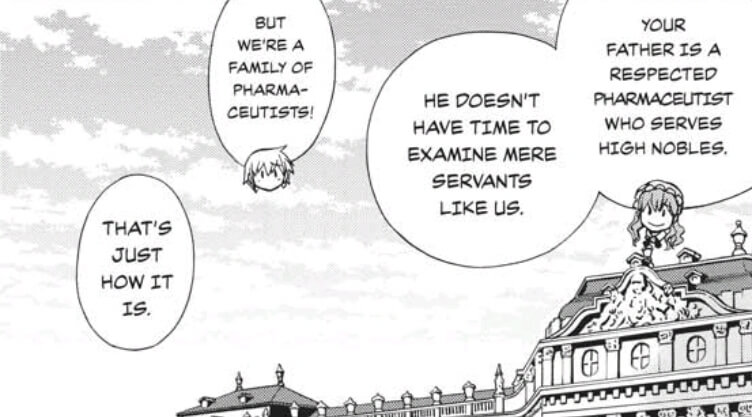
The Verdict
There are a few moments of slapstick comedy that aren’t total busts. There’s clear potential for it to develop into an allegory for real-world medical inequality. But I can’t recommend a story on what it might do eventually. This first volume of Parallel World Pharmacy is mostly a dull slog through worn out tropes and creepy double standards. It’s not terrible but I’d almost prefer it if it was. At least that way it’d be memorable.
You can purchase Parallel World Pharmacy Volume 1 from Barnes and Noble, Amazon, Bookshop, and Right Stuf.
If you like Parallel World Pharmacy you might also like…
- Cooking With Wild Game
- Ascendance of a Bookworm
- Cautious Hero: The Hero Is Overpowered but Overly Cautious
Credits
Manga: Sei Takano
Original Story: Liz Takayama
Character Design: keepout
Translation: Kristi Iwashiro
Pharmacist: Yuushi Kojima
MD-PHD: Kirin
Physician: Minoru Nakazaki
Medical Researcher: Tamaki
Physician, MD-PHD: Souyakuchan
A special thank you to One Peace Books for allowing us the opportunity to review this title. Receiving a review copy has in no way altered the opinions expressed in this article.
The Good
- Art style has a pleasant, slightly older-school look to it
- Full of potential for interesting plot threads about class-based inequality in medicine
The Bad
- First volume never actually executes on its potential
- Uniquely creepy fanservice
- Painfully dense dialogue at times
- Falls into many of the same old isekai tropes and traps

Featured Sponsor - JAST
The sweetest romance and the darkest corruption, the biggest titles and the indie darlings; for visual novels and eroge, there's nowhere better.
Big thank you to our supporters
From their continous support, we are able to pay our team for their time and hard work on the site.
We have a Thank-You page dedicated to those who help us continue the work that we’ve been doing.
See our thank you page